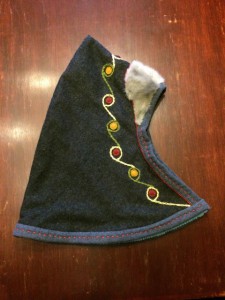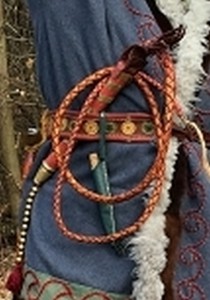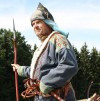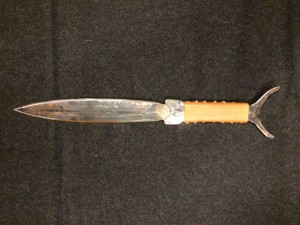Equipment Scythian from the Northern Black Sea Region
 Unless otherwise stated, the objects shown are reproductions of the original state. If features such as color, object parts etc. were added by us, it is noted.
Unless otherwise stated, the objects shown are reproductions of the original state. If features such as color, object parts etc. were added by us, it is noted.
[peg]
The pontic scythian garment is well known from its numerous toreutic-objects, such as, illustrations on metal vessels, jewelries, coins etc. But they do not give any information about the color of the garments. In the selection of the colors, we have therefore used comparative findings (for example, Pazyryk) or smallest archaeological findings of textile fibers. In addition, we always pay attention to herbal dyeing. Wool, leather and hemp are archaeologically and literarily referred materials.
read more...Literature:
Rolle, R., Müller-Wille, M. und K. Schietzel (Hg.): Gold der Steppe. Archäologie der Ukraine, 105-110.
Coat (Gajmanova Mogila; 4. Jh. v. d. Z.)
The Scythian folding coats were mostly made of wool and were usually hemmed with fur. Frequently, the shoulders and seams were visually accented by ribbons of fur or patterned ribbons. Presumably in some cases, the fabric partitions had large looped embroidery, which is proofed by archeological finds. Noticeable are the pointed tails on the lower hem of the coat, which is a characteristic of scythian folding coats.
read more...Literature:
Rolle, R., Müller-Wille, M. und K. Schietzel (Hg.): Gold der Steppe. Archäologie der Ukraine, 105-110.
 Trousers (Solocha, 4th century BC)
Trousers (Solocha, 4th century BC)
The Scythians were mounted nomads, which required appropriate riding-wear. They therefore wore trousers, in contrast to the ancient Greek and later Roman ideal, which regarded trousers as the embodiment of barbarism and uncivilized societies, to protect the rider from friction. Although the exact pattern is not recognizable by means of the toreutical works of the Black Sea region, it can be assumed, based on the comparative findings from Xinjiang and Pazyryk, that a gusset was inserted in the crotch. The trousers, like the rest of the nomadic clothing, were worked in colorful fabrics and also had narrow trims, which at least covered the outer seams. They could also be composed of different, patterned fabrics, which are usually added in the vertical direction. The material may have been wool, but also leather is to be considered.
read more...Literature:
Sembach, K. und G. von Haeseler (Hg.): Gold der Skythen aus der Leningrader Eremitage, 96-99.
Boots (Kul’-Oba, 4th century BC)
The riding clothes also included short boots made of soft leather and depending on the design, could reach just over the ankle or up to half of the calf. They were fixed with leather straps which were either wrapped around the ankle or additionally and sometimes several times around the tensioning range. The boots can be seen on many archaeological discoveries with anthropomorphic image-subjects.
read more...Literature:
Rolle, R., Müller-Wille, M. und K. Schietzel (Hg.): Gold der Steppe. Archäologie der Ukraine, 105-110.
 Cap (Kul’-Oba, 4th century BC)
Cap (Kul’-Oba, 4th century BC)
As a headgear a characteristic cap was worn with a pointedly or forwardly inclined tip. This “Scythian cap” (also known as the “Phrygian cap”) was used throughout the whole steppe belt by the Eurasian mounted nomads, and was used as a synonym for barbarism in the program of ancient Greek and later Roman art. It was made of felt, wool or leather.
read more...Literature:
Sembach, K. und G. von Haeseler (Hg.): Gold der Skythen aus der Leningrader Eremitage, 111-117.
 Whip (Elizavetovskoe Gorodišče, Five-Brothers-Kurgan 8, 2nd half of the 4th century BC)
Whip (Elizavetovskoe Gorodišče, Five-Brothers-Kurgan 8, 2nd half of the 4th century BC)
Whips were a tool, a weapon and a status symbol of the scythian time nomads of Eurasia. Both simple variants as well as magnificently designed specimens decorated with gold and animal ornamentation are documented by archaeological finds and illustrations.
Of this whip only the components of gold were found. The handle of a transient material such as wood, horn or bone was no longer preserved and made of us from wood with red color. It was bordered by a long ribbon of gold-plate with a dotted border decoration and a golden spout. There were also twelve golden pearls, which were presumably attached to the handle.
Literature:
Wamers, E. und D. Stutzinger (Hg.): Steppengold. Grabschätze der Skythen und Sarmaten am unteren Don, 82.
 Bow, Arrows and Goryt (Archangel’skaya Sloboda, Kurgan 5, 5th – 3rd century BC)
Bow, Arrows and Goryt (Archangel’skaya Sloboda, Kurgan 5, 5th – 3rd century BC)
The basic equipment of the warriors of the scythian time mounted warriors was the bow. It was stowed in a so-called Goryt, a combined bow and arrow bag. The Goryt could be made of simple leather according to the social rank of the owner or be richly decorated with gold. The bows used by the mounted warriors were composite reflex bows. They are glued together from different materials (horn, tendon, wood) and have a backward curvature in the untensioned state, which gives them a high puncture force. Arrows with three-lobed points were shot, which, depending on the length of the bow, were of different sizes and often painted in a colorful manner. The original animal-style-plates which were attached to this Goryt were made of pure gold and found in Archangel’skaya.
read more...Literature:
Rolle, R., Müller-Wille, M. und K. Schietzel (Hg.): Gold der Steppe. Archäologie der Ukraine, 143-149 und 304f.
The short-sword was one of the characteristic weapons of the nomads and was mainly used in the west of the steppe belt. Although there were also isolated long-swords, but clearly short-blade weapons dominate, which often reach no more than half a meter in length and were mainly used as a stitch weapon. The weapon was carried in a typical sword sheath with a wide flap, as known from grave finds and illustrations.
read more...Literature:
Topal, D.: Akinakai on the western frontiers of Scythia. Scythian swords and daggers from the territory on the Republic of Moldova, 13.
Spear (5th to 3rd century BC)
Spear- and lance-heads are often found in the graves of the nomads. The spears usually had a length of 170 to 220 cm, the tips being on average no longer than 30 to 40 cm having a triangular or rhombic shape. The spears were used by horse as a thrusting or throwing weapon.
read more...Literature:
Seipel, W. (Hg.): Gold der Steppe. Fürstenschätze jenseits des Alexanderreichs, 120f.



